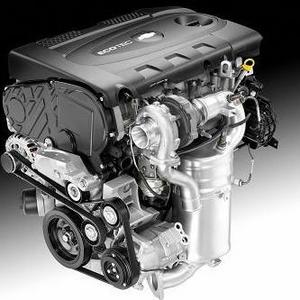Global diesel engine sales forecast to rise 7.7 percent a year

Photo: General Motors Corp.
April 29, 2014
BY The Freedonia Group Inc.
Global diesel engine sales are forecast to rise 7.7 percent per year through 2017 to $248.5 billion, representing a marked acceleration from the 2007-‘12 pace. Higher production of medium and heavy trucks and buses and of off-highway machinery will combine with a rebound in light vehicle output in western Europe and the growing popularity of diesel cars in a number of nations, most notably the U.S. and India, to generate increased engine demand. These and other trends are presented in “World Diesel Engines,” a new study from The Freedonia Group Inc., a Cleveland, Ohio-based market research firm.
According to analyst Matthew Raskind, “In 2012, the Asia/Pacific region was the largest user of diesel engines by a wide margin. This is due primarily to the massive Chinese, Indian and Japanese markets, which represent three of the five largest national buyers of diesel engines on a global scale.” China and India will also be among the fastest expanding national markets through 2017, spurred by rapidly climbing production of diesel-powered motor vehicles and off-highway machinery. Regional sales gains will be restrained to some degree by a sharp deceleration in the Japanese market, reflecting a drop in motor vehicle output as locally based automakers continue to boost manufacturing capacity overseas.
Demand for diesel engines will rebound in western Europe, supported by a recovery in the area’s economy following the debt-related recessions experienced in a number of nations in 2012. Diesel light vehicles made in western Europe are considered to be the gold standard for diesel passenger cars, and an upturn in vehicle sales in the region, the growing popularity of these cars in the U.S., and rising incomes in several large developing countries will boost production levels. North America will also see an increase in diesel engine sales growth through 2017. Value gains in North America will be concentrated in the large medium/heavy vehicle and off-highway and other mobile machinery markets, and will be supported by improved economic conditions and greater investment in construction and mining projects around the world.
|
WORLD DIESEL ENGINE DEMAND (billion dollars)
|
|||||
|
% Annual Growth |
|||||
|
Item |
2007 |
2012 |
2017 |
2007- 2012 |
2012- 2017 |
|
|
|
|
|
|
|
|
Diesel Engine Demand |
141.7 | ||||
Advertisement
171.5
248.5
3.9
7.7
North America
18.6
23.2
32.3
4.5
6.9
Western Europe
54.8
43.3
57.2
-4.6
5.7
Asia/Pacific
43.6
74.3
113.5
11.3
8.8
Central & South America
Advertisement
7.1
9.4
14.2
5.9
8.6
Eastern Europe
11.5
13.2
18.7
2.8
7.2
Africa/Mideast
6.3
8.2
12.7
5.5
9.1
The 486-page report, “World Diesel Engines,” published in this April, is available for $6,200 from The Freedonia Group Inc.
Related Stories
Moeve has reached a strategic agreement with Grupo Armas Trasmediterránea to supply 2G marine biofuels in the Canary Islands, with approximately 40,000 tons to be delivered through December 2025 under a long-term contract.
Castle & Cooke Aviation, a premier provider of luxury FBO services, now offers sustainable aviation fuel (SAF) from Avfuel Corp. at Van Nuys Airport (VNY) in Southern California. The SAF produced by Neste.
The Singapore Airlines Group has signed agreements with Neste and World Energy to acquire sustainable aviation fuel (SAF) and SAF certificates, respectively. The purchases include 1,000 metric tons of neat SAF from Neste.
Keolis Commuter Services, the Massachusetts Bay Transportation Authority’s operations and maintenance partner for the Commuter Rail, has launched an alternative fuel pilot utilizing renewable diesel for some locomotives.
Luxury North Dakota FBO, Overland Aviation—together with leading independent fuel supplier, Avfuel Corp.— on May 19 announced it accepted a 8,000-gallon delivery of sustainable aviation fuel (SAF) on May 12.
Upcoming Events










